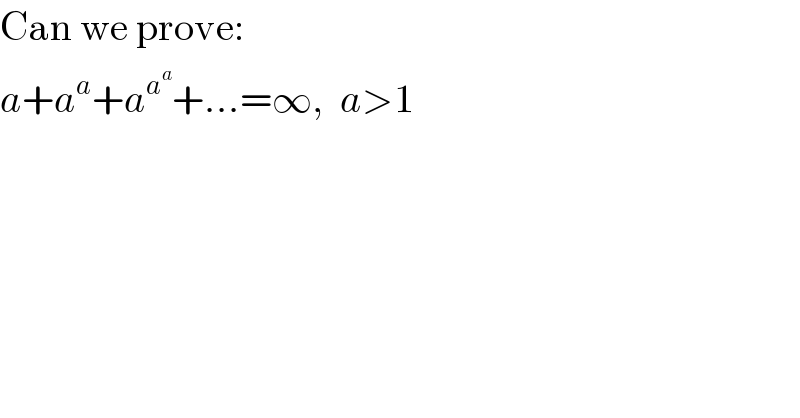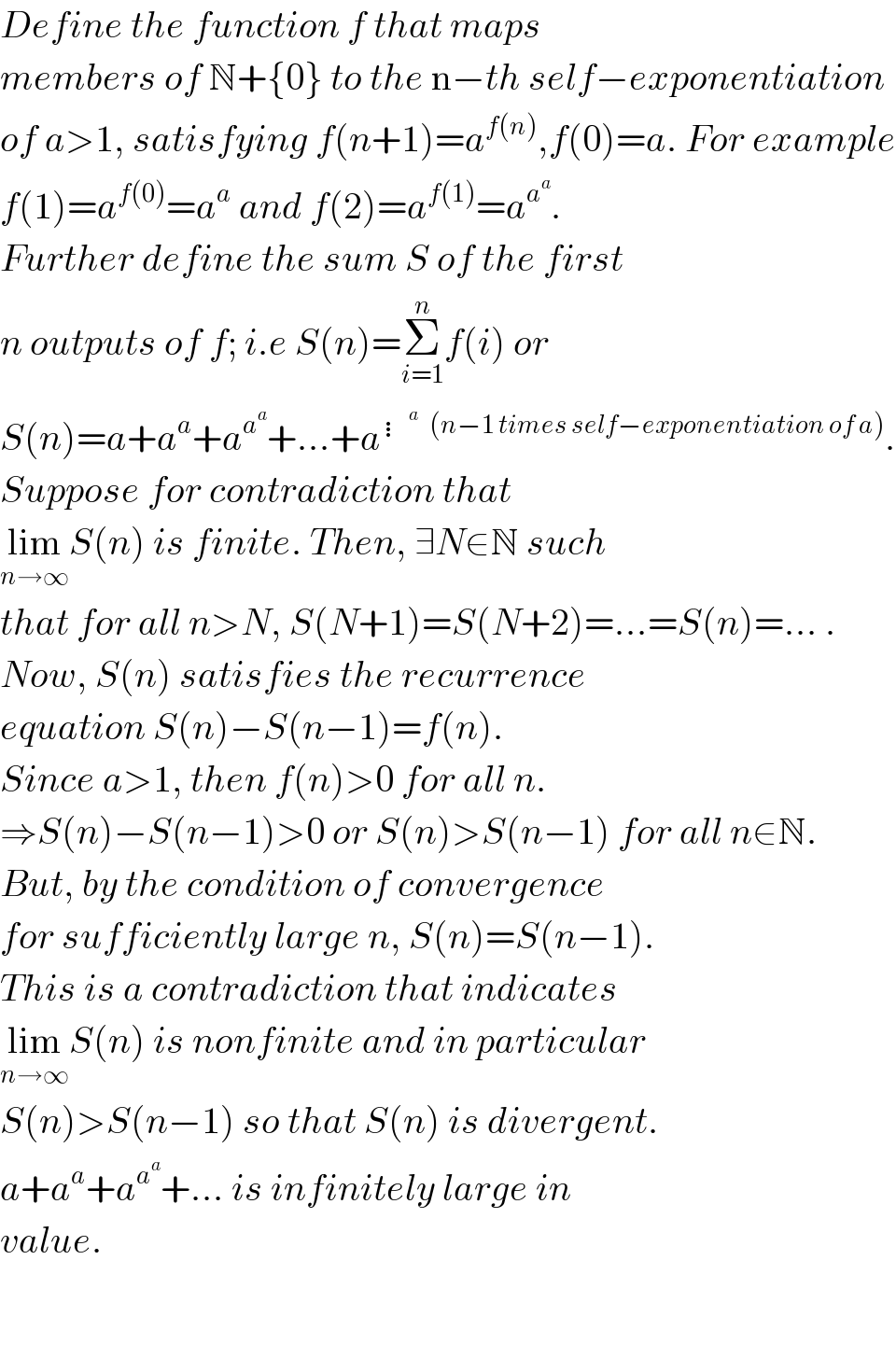Question Number 5081 by FilupSmith last updated on 10/Apr/16

$$\mathrm{Can}\:\mathrm{we}\:\mathrm{prove}: \\ $$$${a}+{a}^{{a}} +{a}^{{a}^{{a}} } +…=\infty,\:\:{a}>\mathrm{1} \\ $$
Answered by Yozzii last updated on 11/Apr/16

$${Define}\:{the}\:{function}\:{f}\:{that}\:{maps}\: \\ $$$${members}\:{of}\:\mathbb{N}+\left\{\mathrm{0}\right\}\:{to}\:{the}\:\mathrm{n}−{th}\:{self}−{exponentiation} \\ $$$${of}\:{a}>\mathrm{1},\:{satisfying}\:{f}\left({n}+\mathrm{1}\right)={a}^{{f}\left({n}\right)} ,{f}\left(\mathrm{0}\right)={a}.\:{For}\:{example} \\ $$$${f}\left(\mathrm{1}\right)={a}^{{f}\left(\mathrm{0}\right)} ={a}^{{a}} \:{and}\:{f}\left(\mathrm{2}\right)={a}^{{f}\left(\mathrm{1}\right)} ={a}^{{a}^{{a}} } . \\ $$$${Further}\:{define}\:{the}\:{sum}\:{S}\:{of}\:{the}\:{first} \\ $$$${n}\:{outputs}\:{of}\:{f};\:{i}.{e}\:{S}\left({n}\right)=\underset{{i}=\mathrm{1}} {\overset{{n}} {\sum}}{f}\left({i}\right)\:{or} \\ $$$${S}\left({n}\right)={a}+{a}^{{a}} +{a}^{{a}^{{a}} } +…+{a}^{\vdots^{{a}} \:\:\:\left({n}−\mathrm{1}\:{times}\:{self}−{exponentiation}\:{of}\:{a}\right)} . \\ $$$${Suppose}\:{for}\:{contradiction}\:{that}\: \\ $$$$\underset{{n}\rightarrow\infty} {\mathrm{lim}}{S}\left({n}\right)\:{is}\:{finite}.\:{Then},\:\exists{N}\in\mathbb{N}\:{such} \\ $$$${that}\:{for}\:{all}\:{n}>{N},\:{S}\left({N}+\mathrm{1}\right)={S}\left({N}+\mathrm{2}\right)=…={S}\left({n}\right)=…\:. \\ $$$${Now},\:{S}\left({n}\right)\:{satisfies}\:{the}\:{recurrence} \\ $$$${equation}\:{S}\left({n}\right)−{S}\left({n}−\mathrm{1}\right)={f}\left({n}\right). \\ $$$${Since}\:{a}>\mathrm{1},\:{then}\:{f}\left({n}\right)>\mathrm{0}\:{for}\:{all}\:{n}. \\ $$$$\Rightarrow{S}\left({n}\right)−{S}\left({n}−\mathrm{1}\right)>\mathrm{0}\:{or}\:{S}\left({n}\right)>{S}\left({n}−\mathrm{1}\right)\:{for}\:{all}\:{n}\in\mathbb{N}. \\ $$$${But},\:{by}\:{the}\:{condition}\:{of}\:{convergence} \\ $$$${for}\:{sufficiently}\:{large}\:{n},\:{S}\left({n}\right)={S}\left({n}−\mathrm{1}\right). \\ $$$${This}\:{is}\:{a}\:{contradiction}\:{that}\:{indicates} \\ $$$$\underset{{n}\rightarrow\infty} {\mathrm{lim}}{S}\left({n}\right)\:{is}\:{nonfinite}\:{and}\:{in}\:{particular} \\ $$$${S}\left({n}\right)>{S}\left({n}−\mathrm{1}\right)\:{so}\:{that}\:{S}\left({n}\right)\:{is}\:{divergent}. \\ $$$${a}+{a}^{{a}} +{a}^{{a}^{{a}} } +…\:{is}\:{infinitely}\:{large}\:{in} \\ $$$${value}.\: \\ $$$$ \\ $$$$ \\ $$
Commented by FilupSmith last updated on 11/Apr/16

$${A}\mathrm{mazing}\:\mathrm{proof}!! \\ $$
